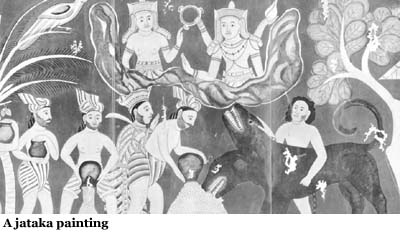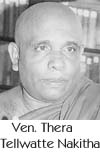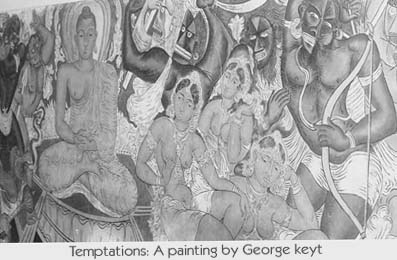

![]()
Puritanical Theravada, it is true, frowned upon such arts as disturbed the senses. Nevertheless, it is equally true that practically all our paintings are connected with religion and that monks are recorded as having practised the art. There is the story of the ancient recluse who, though living in his cave for sixty years, never saw that the walls had paintings on them.
There is also the case of the chief monk of the eighteenth century Degaldoruwa temple who actively supervised the work, including that of Devaragampala Silvet-tena, a sort of lay -brother who did the best decorative work of the period.
The object of the artist was the edification of the worshipper. That is how we may intepret the function of the monk in temple art. In this context one appreciates, rather than frowns upon, the pillar-carving done in the Chapter House in the past by a monk of the Asgiriya Chapter which set the model for the rest of the work by laymen.
Whether in Theravada or Mahayana we see that Buddhist art was used for didactic purposes and in such light that it never excited the senses to a degree we should expect of it even from such a topic as, for instance, the intimate scene which could have once been seen at the Polonnaruwa Tivankage. Temples had the rich source of Jataka stories to draw from.
These, perhaps the finest folk-tales of any people, had an appeal which never staled as all the world, loves a story. The garland of 550 Birth Stories of the Buddha-to-be were as they are, a wonder and delight to the pious pilgrim who makes his round of shrines on a holy day. These tales illustrated the walls of a temple.
Every painting had its meaning, which was to teach a Paramita (Perfection). So the pilgrim, he was the art critic now, would seek, "Has the Perfection of Charity (Dana Paramita) been truly portrayed by the painter (Sittara)?."
The Dambulla caves had painted walls from ancient times, as one may feel from such pieces as the elephant group. These caves date from at least the time of King Valagamba, if not earlier Saddha Tissa, brother of Dutugemunu. The Vahalkadas of the well-known Anuradhapura dagabas contain traces of painting. The ruined image-houses, such as that magnificent one by the Jetavana Dagaba, surely had painted walls, even as we see those at Polonnaruwa of the twelfth century. Earlier still we have Hindagala, Pulligoda-galge and others with painted walls. And we know from the chronicles that there was a sort of Art Gallery in the capital city of Parakramabahu 1 in the twelfth century. That was the mural tradition which came through the Gampola, Lankatilaka and Gadaladeniya, Kurunegala with Kebella-lena cave painting, Kotte and Kelaniya (in later history) down to practically our own times of the Kandy period which ended with the deposition of 1815. Meanwhile, though under foreign duress, the sea-board had its own mural work such as at Telwatte and the Matara tradition.
The important point to remember is that there was a continuous tradition. The indigenous Sittara art persisted. Encouragement was, perhaps after the loss of royalty which patronized the artist, not very profitable but the art never died out completely.
Owing in a large measure to the activity of Kirti Sri Raja Sinha, who was such an eager friend of religion and of art, we find preserved a sufficient amount of eighteenth century painting, such as the work of Silvet-tena, who painted 'Jatakas' at Ridi Vihara and at Degaldoruwa. The eighteenth century work may be best studied in old and unrestored Vihares, such as Kelaniya Vihara and at Degaldoruwa. Ridi Vihara, Damagirigala, Dodantale and in the low-country at Kelaniya.

The wall paintings of 'Degaldoruwa' Vihare, according to 'Degaldoruwa Sannasa'
have twenty-four images of Buddha painted on the walls and ceilings beside
other workmanship. Of those paintings, the 'Jataka' paintings on the outer
surface of the wall of the 'pilima-ge' are the most interesting and important.
Four 'Jatakas' are illustrated; these are the 'Sattubhatta and Vessantara
Jatakas' on the left of the main door, 'Sutasoma Jataka' between the doors
and the 'Silava Jataka' on the right.
In Kandyan painting there is an entire absence of perspective and shading. The primary object is to tell an edifying story in an attractive way. The work is thus rather epic in character, than artistic in the modern sense.
Beside 'Jatakas' we find other subjects on the walls, particularly the 'Sat-satiya' 'Suvisi-vivaranaya' rows of 'Arahat' priests 'Mara-yuddhaya' etc.
Portraits of royal or other patrons are sometimes painted flat on the walls, where there is a valuable costume representation of Kirti Sri wearing the famous 'Kurulla-bendi-malaya' now in the Dalada Maligawa and carrying a jewelled cane; but more often the figure of the patron is modelled in low reliefs. This fact is remarked by the medieval poet Totagamuve in a verse of the 'Sela Lihini Sandesaya' ; "True friends alike when adverse fortune comes or when success, like painted images upon a wall, show not their backs."
In small paintings by good artists, and particularly in renderings of 'Jataka' subjects, the figure and features are sufficiently well done to allow even a critical observer to enjoy the work as a whole, as one decorative construction. Paintings of Buddha are usually carefully and correctly drawn in accordance with the measurements of the canon, but hardly show any appreciation of the physical beauty of the figure.
The most essential character of Kandyan painting, as of Kandyan design in general, is its idealism.'
Recently The Sunday Times spotlighted the deplorable state of the Gothami Vihare murals painted by George Keyt and L.T.P. Manjusiri, both renowned artists.
These murals adorn the 97 year old Gothami Vihare but were seen to be in a neglected state, peeling and cracked in places and subject to insect attack.
The Chief Incumbent Ven. Thero Telwatte Nakitha said his appeals to
the George Keyt Foundation never had a positive response.
Acting on The Sunday Times report Minister Lakshman Jayakody took time off recently to see for himself the state of the murals at the Gothami Vihare.
He told The Sunday Times "I couldn't believe my eyes that they were in such a deplorable condition and I thank The Sunday Times for its exposure of the dilapidated state of these very precious murals.
Minister Jayakody said, "I have asked a pest control squad to treat the murals now attacked by Veyas. A digital camera will keep a record of these murals and finally I have asked H. G. Charles, the well known painter to begin touching up the murals."
"The Ministry will give whatever financial help it could and appeal for funds," he added
 Professor
Seneka Bandaranayake Vice-Chancellor of Kelaniya University contacted by
The Sunday Times, and well known for his work in restoring the Sigiriya
Frescoes said he would send a team from the Cultural Triangle to assess
the damage and "give all the help I can. Kushan Manjusri's son works
with us at the Cultural Triangle and I will ask him to touch up his father's
paintings."
Professor
Seneka Bandaranayake Vice-Chancellor of Kelaniya University contacted by
The Sunday Times, and well known for his work in restoring the Sigiriya
Frescoes said he would send a team from the Cultural Triangle to assess
the damage and "give all the help I can. Kushan Manjusri's son works
with us at the Cultural Triangle and I will ask him to touch up his father's
paintings."
Manjusri's are stylised border paintings and can be seen at the entrance to the temple.
George Keyt has painted vividly and in great detail the temptations the Lord Buddha was subject to as He sat meditating. There is a painting, of Lord Buddha meditating as a child and a beautiful painting most moving showing the birth of his son Rahula. There is also a painting of Lord Buddha as he preached His first sermon.
Ven. Thero Telwatte Nakitha, the Chief Incumbent of the temple expressed his happiness that Minister Jayakody and Prof. Seneka Bandaranayake had agreed to restore the paintings.
Continue to Plus page 4 * Romance by the banks of Mahaweli * Ah, ah,ah…my god!
Return to the Plus contents page
![]()
| HOME PAGE | FRONT PAGE | EDITORIAL/OPINION | NEWS / COMMENT | BUSINESS
Please send your comments and suggestions on this web site to
info@suntimes.is.lk or to
webmaster@infolabs.is.lk